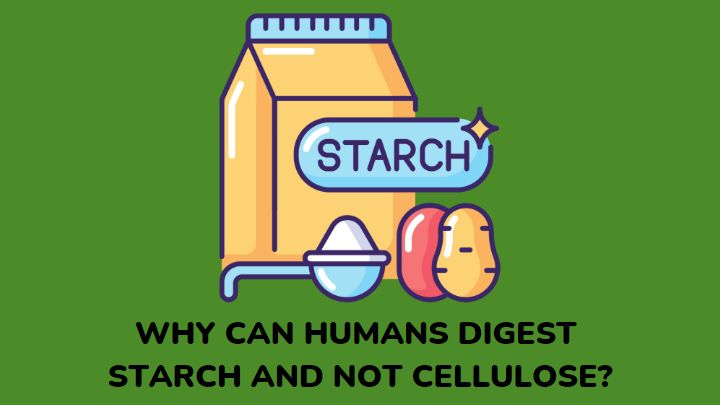The way these two polymers, starch and cellulose, behave is significant but very different in our bodies. Humans can eat and break down starch, but this is different for cellulose. So, why can humans digest starch but not cellulose?
If cellulose is so important, why can’t humans digest it? Does it affect us? These are questions I will review and give adequate answers to in this article.
What is starch?
Starch is an organic white, powdered chemical that all green plants produce. It is soft, white, and doesn’t have a taste. It is granular and insoluble in alcohol, cold water, and other solvents.
The basic chemical formula for starch is (C6 H10 O5)n. Starch is synthesized in the green leaves of plants using the extra glucose produced during photosynthesis to provide plants with a reserve food supply.
This starch is stored in the roots of cassava plants, tubers of potatoes, the stem pith of sago, and seeds of corn, rice, and wheat. It is also present in the chloroplast in the form of granules.
When necessary, starch breaks down into constituent monomer glucose units in the presence of certain enzymes and water. It all diffuses from the cell to nourish the plant tissues.
Starch from plants breaks down into its component sugar molecules in humans and other animals, which in turn provides the tissues with energy.
The majority of the store-bought starch is made from corn, tapioca, potato starch, and wheat. Some are also made by crushing or grinding tubers and seeds that contain starch and mixing the shaft with water. This paste is then dried into a powder.
Apart from the basic nutritional benefits, starch can be used as a brewing and thickening agent.
What is cellulose?
Cellulose is a polysaccharide or complex carbohydrate made up of at least 3000 glucose units. It is the most prevalent of all naturally occurring organic substances and the fundamental structural element of plant cell walls.
Cellulose makes up around 33% of vegetable matter, 90% of cotton, and 50% of foods.
It is a food source for herbivorous animals like cows and horses because they can retain it long enough for the microorganisms in their gastrointestinal tract to break it down.
Termites also have gut protozoans that break down cellulose. Despite all this, it is indigestible to humans.
Why can humans digest starch but not cellulose?
Humans can digest starch but not cellulose because of the activity of certain enzymes in our bodies.
While humans have enzymes that hydrolyze the alpha glycosidic linkages of starch, they do not have enzymes that break down the beta glycosidic linkages of cellulose.
The enzyme responsible for this digestion is called amylase. Amylase can only break alpha glycosidic bonds which are present in the beta forms in cellulose.
Humans digest starch using alpha-amylase to hydrolyze alpha-1, 4, and alpha-1, 6 bonds.
Cellulose is not soluble and largely forms crystalline and insoluble fibers humans cannot digest. However, ruminants can break down cellulose effectively because of the cellulolytic bacteria and fungi in their GI tract.
What are the differences between starch and cellulose?
The difference between starch and cellulose is in their chemical composition, especially around the glycosidic bond. While the units of starch connect by the alpha linkage, the units in cellulose connect by the beta linkage.
The difference in the units and general orientation makes cellulose stronger and harder to break down than starch.
Why didn’t humans evolve to digest cellulose?
While digesting cellulose may give humans an advantage, it doesn’t mean our systems will evolve to break it down.
For anything to go through the process of evolution, important mutations must be present or occur.
From fossil records, only a few living organisms could digest cellulose. The first attempt to break down cellulose resulted in the release of the atmospheric carbon locked into the cellulose by plants that resembled trees.
These plants were the first to manufacture cellulose on a large scale. However, they died and their cellulose did not degrade quickly.
As a result, the atmospheric content of oxygen on earth increased and resulted in the popular giant insects of the Carboniferous era.
All the plants that died with cellulose in them did not rot. Instead, they created great piles of organic woody material that ended up turning into coal. You can trace a very large amount of the coal reserves on earth to this period.
However, some microorganisms evolved to break cellulose down. These groups include some bacteria, protozoans, and fungi present in animals.
Apart from this, nothing else on earth succeeded in evolving the ability to digest cellulose. It shows that breaking cellulose down biochemical is very hard.
So, should humans stop eating vegetables?
No. The cells of edible vegetables contain enzymes, minerals, sugars, antioxidants, vitamins, and other substances that are good for humans.
These nutrients are more abundant in vegetables than in any other food source. These nutrients are preserved inside indigestible cell walls. This means you need to break down the cell walls to absorb these nutrients.
Although humans cannot digest cellulose, they can make use of its significant benefits.
One of these benefits is the high amounts of dietary fiber, which improves colon health. It also keeps stool soft and regulates and feeds the bacterial community that stays there.
FAQs
What living things can digest cellulose?
Animals like cows, termites, horses, and other ruminant animals can digest cellulose.
How do animals digest cellulose?
Animals do not have the enzymes that break cellulose down, but they host microbes that can digest it.
How many forms of starch exist?
The two forms of starch that exist include amylase and amylopectin.
Conclusion
Humans digest starch but not cellulose. However, cellulose in plants is still beneficial to the digestive system.
This fiber aids digestion. It helps to keep food moving through your gut and pushes waste out of the body.
Thank you for reading.
For more informative articles like this, visit Millenora.

